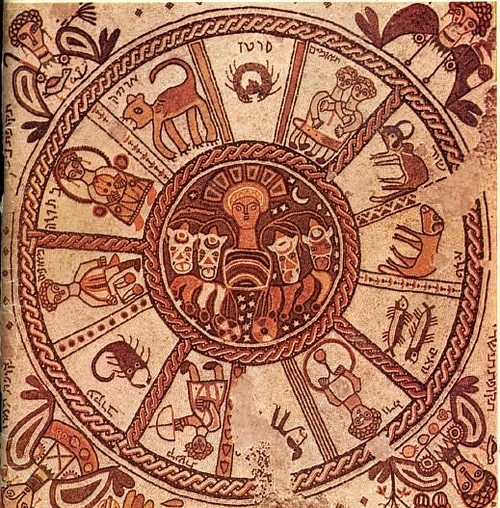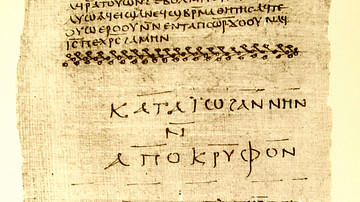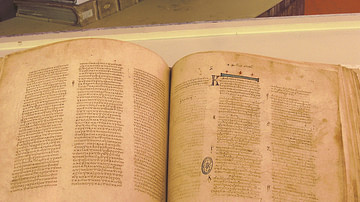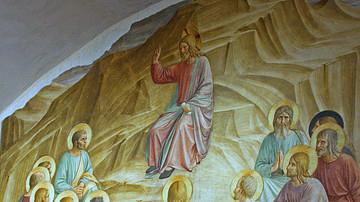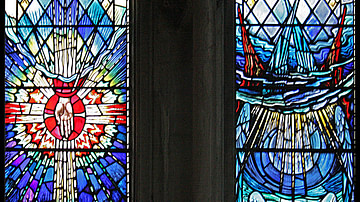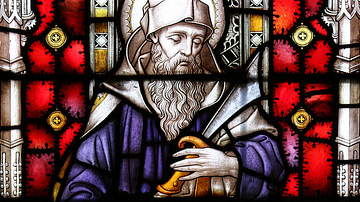The Old Testament Pseudepigrapha are the non-canonical writings of Judaism and Christianity ranging from the 5th century BCE to the 9th century CE. Pseudepigrapha comes from a Greek noun denoting writings with a false superscription or name; however, in modern dialogue surrounding early Christianity and Judaism, it has come to denote non-canonical writings (i.e. Testament of Job, 1 Enoch, Letter of Aristeas) according to the Protestant biblical canon. The Pseudepigrapha are essential to understanding the historical developments and foundations of Judaism and Christianity as they relate to their historical context and demonstrate the various strands of traditions and types of communities.
Definition & framework
What actually constitutes the Old Testament Pseudepigrapha is often contested; however, James Charlesworth provides five basic guidelines in his monumental edited volumes entitled The Old Testament Pseudepigrapha:
The following collection of fifty-two writings together… has evolved from the consensus that the Pseudepigrapha must be defined broadly so as to include all documents that conceivably belong to the Old Testament Pseudepigrapha... Those writings 1) that… are Jewish or Christian; 2) that are often attributed to ideal figures in Israel's past; 3) that customarily claim to contain God's word or message; 4) that frequently build upon ideas and narratives present in the Old Testament; 5) and that almost always were composed either during the period 200 BCE to 200 CE or, though late, apparently preserve, albeit in an edited form, Jewish traditions that date to that period. (Charlesworth, xxv)
As Charlesworth demonstrates, there is a certain ambiguity and uncertainty that comes with utilizing the term “pseudepigrapha”. At the end of the day, though, it must be recognized that this term is primarily meant to indicate a specific group of writings defined by a relatively loose framework. Because there is such variety in the Pseudepigrapha, note that it also operates to describe a collection of texts compiled in his 1983 volumes. In recent scholarly discussion, there is still argumentation about what should and should not be considered Pseudepigrapha, and even if it is a good term to categorize the literature.
Authorship
As mentioned previously, Pseudepigrapha as a Greek term means a false author; however, unlike the modern day in which the author and copyright information is an important part of a book, in antiquity the works were more malleable and open to adjustments, and the authors were less important. So, 2 Baruch, for example, claims to have been written by Jeremiah's disciple named Baruch, a historical figure from the 6th century BCE associated with the writing of the prophetic book in the Hebrew Bible called Jeremiah. Because internal evidence indicates a later date of composition (2nd century CE), we know that it was not written by Baruch. Even so, people did not have problems with attributing the text to an ancient figure, as it provided the text with ancient authority and intrinsic value.
In each Pseudepigrapha, then, we do not know who actually wrote the text. What we can determine oftentimes is where it was written and the worldview of the scribe who wrote the text. Understanding the scribe's view is important because it provides excellent insight into the historical situation and developments in early Judaism and Christianity.
Historical ValuE
The Pseudepigrapha provide a snapshot of a multitude of communities from within early Christianity and Judaism. Ultimately they allow us to see how the various historical situations and socio-religious reactions to conflict. This is reflected in descriptions of other people, theological statements, and appropriations of characters and stories from the Hebrew Bible, also known as the Old Testament.
For example, between the 2nd century BCE and 7th century CE, Jewish and Christian communities composed their own versions of Sibylline Oracles, a well-known literary genre in the ancient world. Heracleides Ponticus (c. 360-325 BCE), a Greek philosopher, considers the original Sibyl to have lived thousands of years before his time; yet, her voice and prophecy were still present. Likewise, Jewish tradition considers the Sybil to be the daughter of Noah. The similarities between how these two traditions interact demonstrate how early Jewish scribes sometimes transferred non-biblical roles to biblical characters. Consequently, we recognize that early Jewish scribes were connected to the world and traditions surrounding them in the midst of Hellenization.
Additionally, within the compiled Sibylline Oracles, we have insight into the developing worldviews of the community the scribes represent. In an appeal to eschatological completion, or things being perfected at the end of times, Sibylline Oracle 3:619-623 discusses what will happen to the world at the end of time:
And then God will give great joy to men,
For earth and trees and countless flocks of sheep
Will give to men the true fruit
Of wine, sweet honey and white milk
And corn, which is best of all for mortals.
(Translation by J. J. Collins)
Notable is that the Sibyl applies the imagery of a land flowing with milk and honey to the entire world despite it being originally used exclusively to the Israelites' “promised land” in the book of Exodus. Based on the internal evidence and its corroboration with external historical evidence, this passage may have been composed between 163 BCE and 145 BCE. In a later Sibylline Oracle, we see a completely different picture illustrated by the scribe:
But the holy land of the pious alone will bear all these things:
A honey-sweet stream from rock and spring,
And heavenly milk will flow for all the righteous.
For with great piety and faith they put their hop
In the one begetter, God, who alone is eminent.
(Translation by J. J. Collins; 5:280-285)
In stark contrast to the previous one, this oracle is significantly more exclusive and applies the imagery of a land flowing with milk and honey exclusively to the land of the pious, or the land of Israel. While both texts agree on many theological ideas, the latter text was written in a period of socio-religious and political turmoil around the period of the destruction of the Second Temple (c. 70 CE) and the Bar Kokhba Revolt (c. 135 CE). These two events mark significant shifts in Jewish and Christian identities. By comparing how these writing, the former from a Jewish community in the 2nd century BCE and the latter from a Jewish community in the 2nd century CE, we see the development of how people actually responded to their historical conflicts and situations. Consequently, this trajectory allows us to better interpret and understand early Jewish and Christian history within their historical context.
Other Pseudepigrapha
There are, of course, many texts considered Pseudepigrapha. The following will highlight select texts and briefly explain ways in which they are valuable to interpreting and understanding ancient history.
1 Enoch (2nd century BCE – 1st century CE) - This text is attributed to Enoch, the seventh generation after Adam and Eve according to biblical tradition. Based on the verse in which God takes Enoch from the earth (Gen. 5:24), 1 Enoch is a composite book about God revealing to Enoch the secrets of the universe, the course of history, and the future. The oldest layers of the book reflect upon the events surrounding the Maccabean Revolt. Also apparent is its influence from other books, demonstrating the development of Judean socio-religious ideology. It influenced 2 Enoch and 3 Enoch, the former written in the 1st century CE and the latter c. 5th century CE.
Sibylline Oracles (2nd century BCE – 7th century CE) - A compilation of several oracles, the Sibylline Oracles within Judeo-Christian tradition are attributed to the daughter of Noah. Following Alexander the Great's establishment of his empire, Judean culture, literature, and religious practice was influenced by Hellenistic culture. The Sibylline Oracles are reflective of how Judeans appropriated non-native literary and prophetic genres for their own intentions. Additionally, throughout the Oracles, we see how the scribes interacted with their historical situations through this literary medium.
Jubilees (161 – 140 BCE) – Based on biblical tradition, especially the books of Genesis and Exodus, Jubilees is a reworked account of what was purportedly revealed to Moses at Mount Sinai. Because it can be dated to approximately 150 BCE, it is valuable in that it reveals the reactions of a group of Jews to the Antiochus IV, who, according to 1 Maccabees, was intolerant of Jewish practices like circumcision, heavily encouraged nudity, and showed severe disrespect to their deity Yahweh, things severely against the sensibilities of Judeans of the time. Consequently, it is also a witness to the foundational ideology of the later Jewish sects, especially the Essene sect who focused greatly on purity.
Treatise of Shem (1st century BCE) – Drawing on the zodiac, this text applies the zodiac to Jewish thought and, beginning with the sign of Aries, writes for the sign of each year. It demonstrates that at the turn of the millennium Jews were, in fact, involved with astrology. Use of the zodiac by Jews at the turn of the millennium provides greater historical background for its presence in Rabbinic Jewish documents and an ancient synagogue from the 6th century CE (Beth Alpha). Additionally, it shows how ancient Jewish scribes developed their worldviews through alternative mediums, in this case the zodiac.
Testament of the Twelve Patriarchs (2nd century BCE) – In the Hebrew Bible, Jacob has twelve sons, each of whom is considered the leader of a tribe of Israel in later traditions. Aside from various Christian additions to the text at a later period, each patriarch in the text has his own section in which he is “reflecting on aspects of his life, confessing his misdeeds, exhorting his family to avoid his sins and exemplify virtue, concluding with predictions about the future of Israel and giving instructions concerning his burial” (H. C. Kee, 776). Most importantly, this text demonstrates the diversity in Judaisms prior to the Maccabean Revolt and, like other Pseudepigrapha, illustrates how certain Hellenistic ideas were appropriated for Jewish identities and worldviews.
Conclusion
These texts are not exhaustive by any means, nor are they representative of the diversity of Pseudepigrapha. Rather, these few selected Pseudepigrapha are meant to illustrate why the literature, commonly known as the Old Testament Pseudepigrapha, is important to understanding the historical foundation of Judaism and Christianity and diversity therein. For scholars, these texts assist in interpreting how the New Testament and Rabbinic Judaism emerged anew from the ruins of the Jerusalem temple in 70 CE. Likewise, they demonstrate and vividly illustrate the diversity in early Judaism and how it connected with its surrounding world and cultures.
